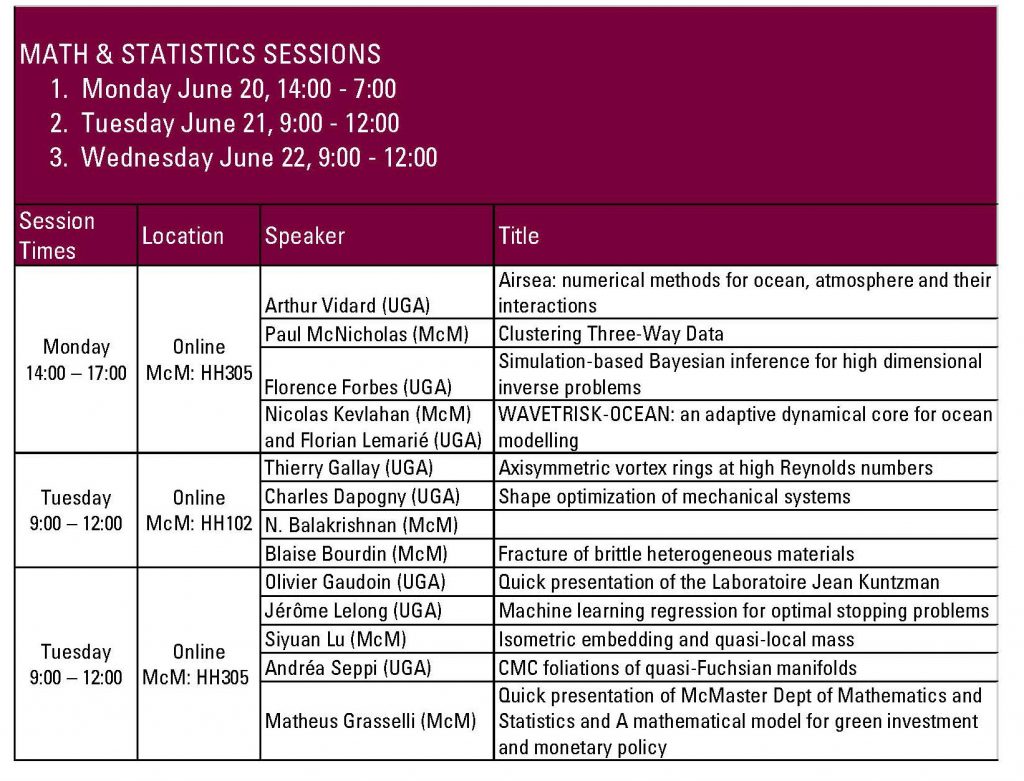Expandable List
Monday 2:00pm – 5:00pm Meeting Recording:
https://mcmaster.zoom.us/rec/share/-ordKhC1Xge6H_z56tSfZgNCSEmDo4ENEpfk5AUQdF7_GDIkmxiWx_KdkFF45u9x.oDe8AapuSoa4n0wI
Access Passcode: we3b1ok?
Tuesday 2:00pm – 5:00pm Meeting Recording:
https://mcmaster.zoom.us/rec/share/EszrQZFo6ywngDRhMq7yddpPhD2Cq4EmfAt0l4uRLhLYwURGEPBLB-SxH4uiVxvk.j1CvTB4VP7DqcxsP
Access Passcode: cE39&1s8
Wednesday 9:00am – 12:00pm Meeting Recording:
https://mcmaster.zoom.us/rec/share/4IuvOiK-730nz9dabzXUCmtCGL1jBxP05ICrf63I8ERNoSxQqcdBbdro0wbmNM5l.9Y0ijiuImayYWwX5
Access Passcode: T8$vqKZ+
Expandable List
Title: Airsea: numerical methods for ocean, atmosphere and their interactions
Abstract:
This presentation will present a tour of current Airsea’s activities. They are targeted to applications covering oceanic and atmospheric modeling and related extreme events using a hierarchy of models of increasing complexity. Its scientific objectives are divided into four major points. The first objective focuses on developing advanced mathematical methods for both the ocean and atmosphere, and the coupling of these two components. The second objective is to investigate the derivation and use of model reduction to face problems associated with the numerical cost of our applications. The third objective is directed toward the management of uncertainty in numerical simulations. The last objective deals with efficient numerical algorithms for new computing platforms.
Expandable List
Title: Clustering Three-Way Data
Expandable List
Title: “Simulation-based Bayesian inference for high dimensional inverse problems”
Abstract: We investigate the use of learning approaches to handle Bayesian inverse problems in a computationally efficient way when the observations to be inverted present a moderately high number of dimensions and are in large number. We propose a tractable inverse regression approach which has the advantage to produce full probability distributions as approximations of the target posterior distributions. These distributions have several interesting features. They provide confidence indices on the predictions and can be combined with importance sampling or approximate Bayesian computations schemes for a better exploration of inverse problems when multiple equivalent solutions exist. They generalise easily to variants that can handle non Gaussian data, dependent or missing observations. The relevance of the proposed approach is illustrated on synthetic examples and on two real data applications, in the context of planetary remote sensing and neuroimaging. The approach shows interesting capabilities both in terms of computational efficiency and multimodal inference.
Expandable List
Title: WAVETRISK-OCEAN: an adaptive dynamical core for ocean modelling
Expandable List
Title: Axisymmetric vortex rings at high Reynolds numbers
Vortex rings are three-dimensional flows characterized by a vorticity distribution that is concentrated in a solid torus. A natural way to construct such flows is to consider axisymmetric solutions without swirl of the 3D Euler or Navier-Stokes equations, assuming that the initial data are suitably localized. We focus on the particular case where the initial vorticity is a single vortex filament, the circulation of which may be arbitrarily large compared to viscosity. We show that the axisymmetric Navier-Stokes equations are globally well-posed in this context, and we perform an asymptotic expansion of the solution in the vanishing viscosity limit. In particular, we obtain a rigorous justification of the binormal flow approximation for the advection speed of a viscous vortex ring with Gaussian profile.
This talks is based on joint work with Vladimir Sverak (Minneapolis).
Expandable List
Title: Shape optimization of mechanical systems
Abstract: This presentation is devoted to the introduction of a recent method for shape and topology optimization which features an explicit (meshed) discretization of the optimized shape — so that precise mechanical calculations can be performed with the finite element method — and still allows for arbitrarily large evolutions of the shape (including topological changes). After recalling a few notions regarding shape optimization, and notably the main ingredients involved in the device of numerical algorithms, we present with a little more details the level set method for shape optimization and spend a few words on meshing aspects, as the building blocks of our method. The main aspects of this framework are illustrated with several numerical examples, in two and three space dimensions. This presentation summarizes a body of work conducted with, in particular, G. Allaire, F. Feppon and P. Frey.
Expandable List
Expandable List
Title: Fracture of brittle heterogeneous materials
Expandable List
Title: Quick presentation of the Laboratoire Jean Kuntzman
Expandable List
Title: Machine learning regression for optimal stopping problems
Abstract: Optimal stopping problems arise in many applications such as gambling games or American options. Optimal stopping problems are usually solved through their dynamic programming principle formulation, in which the main difficulty comes from the conditional expectation involved in the computation of the continuation value. These conditional expectations are classically computed by regression techniques on a finite dimensional vector space, however they scale badly with the dimension of the problem. In this talk, we discuss two alternative regression approaches coming from machine learning: neural networks and random forests. We present theoretical results ensuring the convergence of such approximations and illustrate their efficiency on examples coming from American option pricing.
Expandable List
Title: Isometric embedding and quasi-local mass
Expandable List
Title: CMC foliations of quasi-Fuchsian manifolds
Abstract: Quasi-Fuchsian are an important class of hyperbolic three-manifolds. In this talk I will present several results, obtained in a joint work with Diptaishik Choudhury and Filippo Mazzoli, on their foliations by constant mean curvature (CMC) surfaces. A conjecture due to Thurston asserts that every almost-Fuchsian manifold has a global CMC foliation: in the first part of the talk I will present a partial result in this direction, namely that every quasi-Fuchsian manifold in a neighbourhood of the Fuchsian locus is foliated by CMC surfaces. In the second part of the talk I will then explain how these CMC foliations induce Hamiltonian flows on the cotangent bundle of the Teichmüller space, and give some elements of the proof.
Expandable List
Title: Quick presentation of McMaster Dept of Mathematics and Statistics and A mathematical model for green investment and monetary policy


